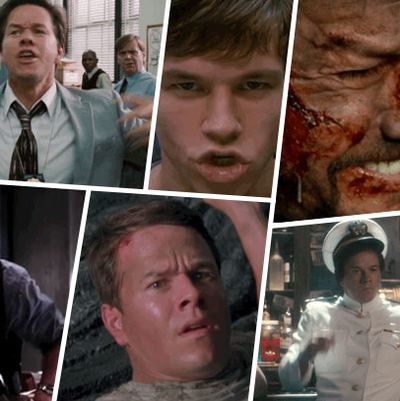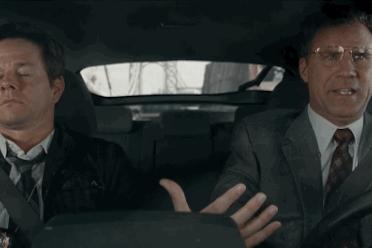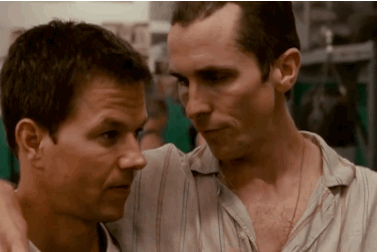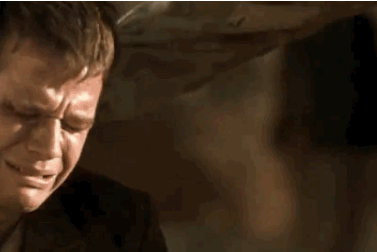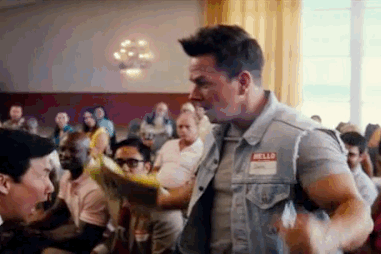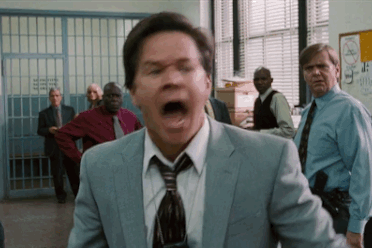We know. Mark Wahlberg playing an inventor in the new Transformers movie feels … off, at least at first glance, and maybe even at second and third glance. As our own David Edelstein put it so well, “I’m sure there are people less suited to being cast as an egghead than Wahlberg, with his swollen pecs and biceps and streetwise Boston diction. Let me think … don’t rush me … Sylvester Stallone? Justin Bieber?” (Apparently, Michael Bay never saw The Happening, which attempted to sell us on the notion of Mark Wahlberg, high-school science teacher.) At the same time, though, don’t let Wahlberg’s odd miscasting in the occasional blockbuster trick you into believing that the man has no range. He does. A physically gifted star who also happens to have one of the most expressive brows of any actor working today, Wahlberg has explored quite a wide variety of parts and emotions since making the leap to feature films in the 1990s. Here are 20 of them.
Emotion: Vigilance
Technique: This is, in many ways, Wahlberg’s natural, base expression — with those eyebrows and that glower, he is a man who is always looking for something. Lone Survivor is a film with a lot of fast cutting, but it makes sense that when it settles into long takes, it’s usually to watch Wahlberg watching out for things. Surveillance is his art.
Emotion: Slow-burning frustration
Technique: The amazing thing about Mark Wahlberg’s face is that it seems to be expressing something even when it isn’t expressing anything at all. (It’s not blank; it’s a canvas.) Here, he deals with the exasperating Will Ferrell. Watch him go from 0 to totally crazy in a split second. This movie, by the way, is a masterpiece.
Emotion: Irritation
Observation: This is a realistic variation on the comic slow burn, but playing off a more flamboyant co-star. Here Wahlberg keeps his face similarly calm, then fidgets his body around, indicating his frustration at his brother’s attention-hogging antics. It’s a nice encapsulation of their relationship in the movie (and one of the actor’s career highs).
Emotion: Bewilderment
Technique: Wahlberg didn’t quite manage to pull off the action-hero bit in Tim Burton’s mediocre 2001 Planet of the Apes remake. But he did pull off the bewildered-human-lost-in-a-planet-full-of-talking-apes bit. The extreme features of his face serve him well here: His grimace becomes one that combines disgust, fear, and total befuddlement. It’s the ultimate WTF face.
Emotion: Loudmouthed hard-assedness (this is totally an emotion, trust us)
Technique: Martin Scorsese’s The Departed is not a comedy, but Wahlberg’s constantly pissy cop often provides the comic relief, with his foulmouthed, rapid-fire tirades at both Leonardo DiCaprio and Matt Damon. It’s actually a delicate balance: Play it too much for laughs, and you ruin the crime-drama; but play it too straight, and the scene becomes strangely meaningless. Watch here how he fixes his eyes, hunches down, and gets a brief maniacal smile on his face. This is a guy who lives to bust balls.
Emotion: Fear
Technique: In one of the most unforgettable scenes from David O. Russell’s Three Kings, Wahlberg’s new-dad character is tortured by a sadistic Iraqi who relates to him the terrible story of how his own young child was killed in a U.S. bombing. Look at his neck — he’s on the verge of hyperventilating, but he’s trying not to show it. It’s an incredibly vulnerable moment.
Emotion: Agony
Technique: Near the end of Three Kings, as Wahlberg cries over fallen comrade Spike Jonze, his anguish is enhanced by the knowledge that, for much of the film, he himself has been the one near death. The way Wahlberg plays the part — as if his body can’t decide whether it’s feeling physical pain for itself, or emotional pain for a fellow soldier — he becomes, in some way, an audience surrogate.
Emotion: Psychosis
Technique: When Mark Wahlberg shows rage, you realize just how exaggerated his features really are — with that gigantic mouth and eyebrows that could be used as shivs. So imagine how terrifying those features are when seen through a distorting eyeglass. Answer: deeply terrifying.
Emotion: Remorse
Technique: Director James Gray made two movies with Wahlberg, which itself should be some kind of testament to the actor’s range, since Gray likes to put his characters through the emotional wringer. Here, Wahlberg is apologizing to his mother after his stint in prison. The way he bows his head and the slow, deliberate movements — he looks like a little boy apologizing for breaking a piece of china.
Emotion: Tenderness
Technique: Despite those mega eyebrows, Wahlberg is actually very good at softening his expression — with the help of bedroom eyes and that placid look on his face. The Perfect Storm has some unfortunate romantic dialogue, but the silent chemistry between his character and Diane Lane’s works better than you’d expect.
Emotion: Love, in a vulnerable way
Observation: Wahlberg has done romantic scenes many times, though there’s a kind of awkwardness to him that doesn’t quite fit a romantic lead. But watch how he slightly recoils from Amy Adams here as she leans in for a kiss. His character is always pulling away in this movie — always afraid to engage, to really go in for the kill. The Fighter is really about the process whereby Wahlberg’s character learns to lean in (as they say) — as he becomes both a real fighter and a real man.
Emotion: Love, in a creepy way
Technique: In Fear, Wahlberg plays a seemingly sweet, perfect boy who seduces Reese Witherspoon’s sheltered high-schooler, only to turn out to be a psycho who finger-bangs her on a roller coaster. Note the discrepancy here: He’s calm and keeping his eyes fixed on her, and also seems to be completely oblivious to the fact that he’s on an effing roller coaster.
Emotion: Adoration
Technique: Wahlberg spends so much time being intense or angry that it’s hard to imagine him being dorky. But here, he is, filling with delight as he gets to fantasize about being with Sam J. Jones, the star of Flash Gordon, his favorite movie. When Wahlberg’s eyes and mouth go big, he becomes a kid again. There’s a primal wonder in that face.
Emotion: Ambition
Technique: Wahlberg has played dreamers a number of times — Boogie Nights, Rock Star, Invincible — but he explores the dark side of American ambition in Pain & Gain, playing a real-life body-builder criminal who, by the end, has been caught and sentenced to death. Still, he keeps his swagger; he’s slower than usual, but he still thinks he’s entitled to it all, and he’s not going to let a little capital punishment get in his way. He’s the ultimate American Dreamer.
Emotion: Triumph
Technique: He’s just gonna keep rockin’ and rollin’. Here’s early Wahlberg on full blast — the intense, karate-kicking dreamer who is determined, yet innocent. And that kick, with its slightly flailing quality, is both hilarious and also kind of sad. He does it with speed, but with little grace. It’s a harbinger of many awful things to come.
Emotion: Irrational exuberance
Technique: Wahlberg has to be everything in Pain & Gain – brilliant enough to concoct this elaborate plan; dumb enough to think he can get away with it; ambitious enough to want to do it in the first place. Remember, though, this is one of the most physically gifted leading men we have: When you watch this beefy, ’roided-up beast jumping up and down like a little kid, you begin to think anything is possible. The movie’s uneven, but Wahlberg is always fantastic.
Emotion: Really stoned
Technique: In real life, Wahlberg has probably enjoyed a toke or two — for proof, listen to his commentary track on the Boogie Nights DVD — but onscreen, “stoned” is not an emotion that comes naturally to him. He always needs to keep busy, so the easiest way to get Wahlberg to look high is to find the one thing potheads do intensely (eat), and to make him do that. The talking teddy bear helps.
Emotion: Existential moment of clarity
Technique: In a movie full of wonderfully showy long takes, the most impressive is simply of Mark Wahlberg’s face as he contemplates the sorry state of his existence in the middle of a drug deal that’s about to go horribly, horribly wrong. It helps that Wahlberg can do so much with so little here: With just a couple of tiny changes, his face goes from exasperation to stoned passivity to pure, cosmic dread to, finally, something resembling determination.
Emotion: Deadpan
Technique: It’s Mark Wahlberg doing Robert Hays doing John Travolta. The key is to keep the totally straight face. Which we know Wahlberg can do.
Emotion: Unbridled desire for freedom
Technique: As a talented cop cooped up in a stultifying desk job and desperate for a chance to prove himself, Wahlberg alternates between slow-burn paralysis and unhinged physicality. Watch the speed with which he bounces around the room here: He’s like a bird. But he’s also out of control: a bird that’s trapped indoors. Which is like literally what he’s saying at this exact moment: “I am a peacock! You gotta let me fly!” (Peacocks can’t fly. Except, in this film, when they do.)
Emotion: More unbridled desire for freedom
Technique: Just kick stuff.
